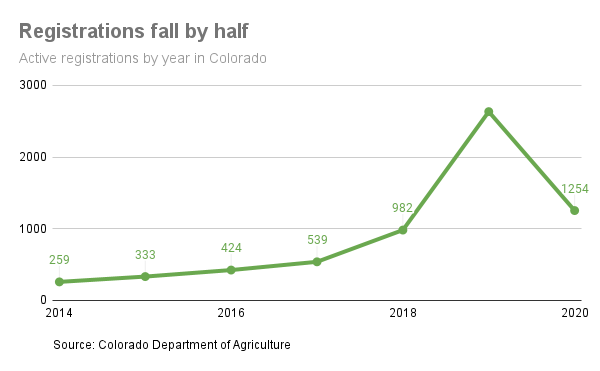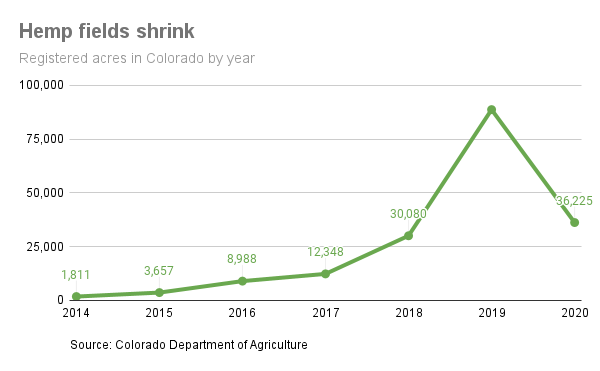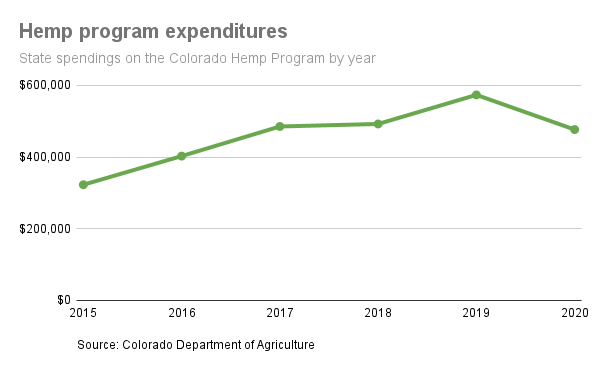Ignoring the aberrant year of 2019, when hemp farming and licensing doubled in Colorado, registrations were still higher in 2020 than in 2018, before the CBD boom and bust. That means Colorado has a group of hard-core hemp stakeholders who are not giving up on the crop.
After the number of registered operators more than doubled to 1,947 in 2019, roughly half that number dropped out in 2020. Registered hemp acres, which were recorded at 88,743 in 2019, more than halved in 2020, dropping to 36,225.
With Colorado’s hemp program now approved by the U.S. Department of Agriculture (USDA), state officials say they hope to build out from that hard core by continuing to advance the interests of small family farmers as they increase support for the industry’s expansion.

CDA’s hemp goals
“We look forward to seeing how hemp can be further developed for fuel, food, and other uses while being a source of revenue for family farms,” Gov. Jared Polis said in a press release from the Colorado Department of Agriculture (CDA).
In addition to its focus on small famers, the Polis administration has committed to implementing large-scale initiatives to support research, the development of processing centers, and financial bonuses for hemp farmers under the Colorado Hemp Advancement and Management Plan (CHAMP).
The governor’s office said the state hemp program also puts environmental and renewable energy goals high on the agenda, including the Polis administration’s goal to achieve 100% renewable energy in the state by 2040.
The CDA submitted its original hemp plan after publication of the USDA’s Interim Final Rule (IFR) on hemp in 2019. USDA requested changes, and the state then re-submitted the plan in August 2020 after revisions that resulted from extensive negotiations with the federal agriculture agency. Approval came last month.

‘Undisputed leader’
“Colorado is the undisputed leader in the cannabis industry, and our hemp plan is a model for the country,” Polis wrote in a letter that accompanied the final Colorado plan. And while the governor commended USDA for improving regulations in a revised Final Rule which went into effect in March of this year, he also took the occasion to notify USDA that “CDA will continue to advocate for additional rule revisions to create even more flexibility for producers.”
Colorado’s hemp program has grown exponentially and CDA’s regulatory footprint has expanded along with registrations and acreage, the state noted in the final hemp plan submitted to USDA, adding that authorization was granted to increase CDA’s spending in fiscal year 2020-2021. The agency said it will continue to grow the regulatory program to scale with the industry.
“Importantly, the success of Colorado’s hemp program is the result not only of the robust state regulatory environment, but also of the community of hemp cultivators, product manufacturers, and ancillary business operators and stakeholders who have helped drive the growth of the program,” the plan points out.

Challenges remain
Since 2015 “the program has rapidly scaled up production, launched a certified seed program, diversified supply chains, and is establishing a statewide Hemp Center of Excellence, which will help direct research, outreach, and educational efforts for Colorado’s hemp industry,” according to the CDA release.
Still, Colorado’s hemp industry faces the universal challenges of finding or developing technology for hemp farming and processing, and workers with technical skills for the modern agri-industry.
Pollen drift, in which female marijuana or hemp plants are inadvertently pollinated by a neighboring crop of male plants, is also a challenge. The phenomenon can affect both outdoor and indoor grows, and lead to crop losses in both types of cannabis. A Colorado House working group is considering measures to address that problem.

